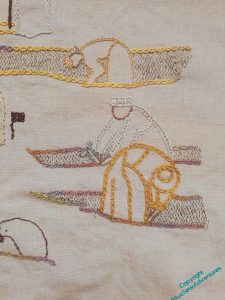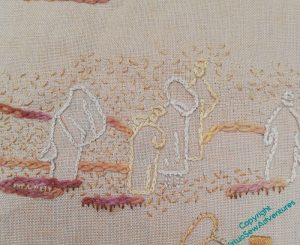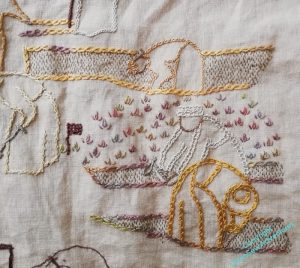Beginning the additions to the Excavation
There will be a lot to do, I think, to bring the Excavation up to balance the Map properly. In my usual fashion, I will sneak up on this, doing what seems obvious and then waiting to see what seems necessary.
The first thing that was obvious was that something should be done to point up the idea of the trenches being dug. Row upon row of vertical running stitches seemed to me to suggest the walls of a trench – maybe not accurately, since the book suggests more of an open area excavation. The photographs I used as my source for this, however, suggested that there were at least a few individual trenches.
The next obvious element was a dust cloud to suggest activity stretching into the distance. Tiny random seed stitches in two or three shades of stranded silk were, again, the obvious choice, although I do wonder, now, whether those will be sufficiently emphatic when I set the panels side by side again.
As I believe I’ve already mentioned – random stitching is really quite difficult to achieve!
At this point I decided it needed much more “weight” at the bottom of the image, and chose to use tête de boeuf stitch (upside down to resemble a plant) as I did originally on the Map to suggest the cultivation on the far side of the river. These tête de boeuf stitches are much bigger than the ones on the map, using two strands of the variegated silk thread, and I’m going to spread them right across the breadth of the panel towards the bottom.




Things are getting very interesting on this panel now. The sketchy original version was fine, but to balance a map you need to get the viewer into a map-like mindset – little things to look at and think about. It helps that there’s no great sense of perspective too. It’s a surface. You’ve solved this.
Really random stitching has a one in umpteen-zillion chance of looking right. The apparently casual scattering that you are doing with your dots, dashes and tête de boeuf is careful. And yes, it’s not easy to get the balance right.
This is looking marvelous, and so good to be able to see close up details of all the wonderful variety of stitches you have used for the figures and ground. I have just been back through your previous posts about this, and have had to speak sternly to myself before I succumbed to buying one (at least) of Edith John’s books from a well known online market place!!
And yes, you are so right, random is really hard; every time you add a stitch you doubt its placing, forgetting that once finished the stitches will blend and odd bits of non random will fade into the whole. Your tete de bouf is a very effective choice
You are so good at selecting the right stitch for the right situation or place.
Random stitches, like Seed Stitches, are difficult to place randomly! I wonder why, are we troubled by the loose lengths of thread on the back, or is the stitch direction and moving the hoop around bothering us?
Your choice of sandy colours and tones helps to make the scene dusty.
You have managed to include so much detail in this and I like your choice of stitches.
I love the concept of sneaking up on it – and I know exactly what you mean! You seem to have this all under control, it’s looking marvellous
Your random stitching looks great – and I love the tete de boeuf.This really has a beautiful color sense to the whole thing. This entire project has been so fun to watch from the sidelines, but seems immensely complicated to actually work on.
I loved clicking on the photos to see close ups of your stitching. I think the stitches absolutely give that illusion of dust to breathe in!